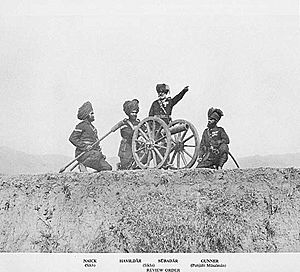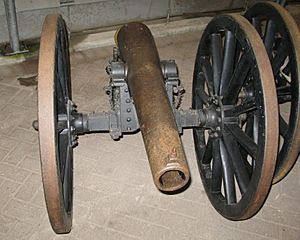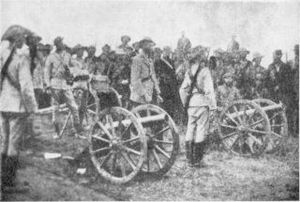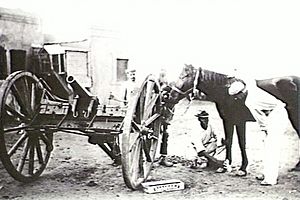RML 7-pounder Mountain Gun facts for kids
Quick facts for kids Ordnance RML 7-pounder Mk IV Mountain Gun |
|
|---|---|

No. 4 (Hazara) Mountain Battery with RML 7-pounder circa. 1895
|
|
| Type | Mountain gun |
| Place of origin | United Kingdom |
| Service history | |
| In service | 1873 – 19? |
| Used by | |
| Wars | Anglo-Zulu War First Boer War Second Boer War Anglo-Aro War |
| Specifications | |
| Mass | 200 lb (91 kg) barrel |
| Barrel length | 3 ft (0.91 m) |
|
|
|
| Shell | 7 lb 11 oz (3.5 kg) (shrapnel) 7 lb 4 oz (3.3 kg) (common) 12 lb 4 oz (5.6 kg) (double) |
| Calibre | 3 in (76 mm) |
| Traverse | nil |
| Muzzle velocity | 968 ft/s (295 m/s) |
| Maximum firing range | 3,000 yd (2,700 m) |
The Ordnance RML 7-pounder Mk IV "Steel Gun" was a special type of British rifled muzzle-loading mountain gun. "RML" stands for "Rifled Muzzle Loader," meaning the inside of the barrel had grooves (rifling) to make the shell spin, and it was loaded from the front (muzzle). The "7-pounder" part meant that the shell it fired weighed about 7 pounds.
Contents
History of the 7-pounder Gun
Work on this gun started in 1864. The goal was to replace an older gun, the RBL 6-pounder, which was too heavy for mountain use. Soldiers needed a lighter gun they could carry easily in tough mountain areas.
At first, they tried making 7-pounder guns from old bronze cannons. But these were still too heavy. So, new barrels were made from steel. This gun was actually the very first British gun made entirely of steel, which is why it was called the "Steel Gun."
Different versions (Marks) of the steel gun were tested. The Mk IV version, which weighed about 200 pounds, was chosen for production in 1873. This gun was later replaced by the RML 2.5-inch Mountain Gun starting in 1879.
How the Gun Was Used in Battles
This mountain gun was quite fast to use. Soldiers could put it together and load a shell in just 20 seconds. The regular shell it fired, called a "common shell," wasn't always very effective.
To help it shoot at high angles, a longer "double shell" was made. This shell had more explosive inside. It was fired with less gunpowder, but sometimes the shell didn't work right because it was too long or didn't spin enough. The shells spun because of small studs on their sides that fit into the rifling grooves inside the barrel.
Anglo-Zulu War (1879)
During this war, Britain used several of these guns. They were put on special "Colonial" carriages. These were light field gun carriages with bigger, wider wheels. This design made them good for being pulled by horses across tall grass.
Two of these guns were lost during a very difficult battle called Battle of Isandlwana.
Second Anglo-Afghan War (1878–1880)

A photograph from the Second Anglo-Afghan War seems to show an RML 7-pounder Mountain Gun. This war started because Britain was worried about Russia's influence in Afghanistan. British forces from India invaded Afghanistan.
The war had two main parts. It ended in September 1880 with the Battle of Kandahar.
First Boer War (1880–1881)
Britain used four of these guns during this war. They were mounted on standard small mountain carriages, which made them easier to move in hilly areas.
War of the Golden Stool (1900)
The West African Frontier Force used several 7-pounder guns in the War of the Golden Stool. These guns were very helpful in this campaign. Other groups, like the Central African Regiment, also had batteries of these guns.
Second Boer War (1899–1902)
In this war, the gun was sometimes put on armored trains. Local volunteer groups also used them early in the conflict.
The gun was also used on regular field carriages. These carriages had larger wheels, which helped the gun move better through tall grass and allowed horses to pull it more easily.
Anglo-Aro War
During the battles around Arochukwu, the British Aro Field Force used one 7-pounder gun.
See also
- Battle of Laing's Nek
- List of mountain artillery
Surviving Examples

Today, you can still find several examples of these guns around the world:
- At the Regional Military Training Center in Darulaman Garrison, Kabul, Afghanistan.
- At the Royal Armoury, Fort Nelson, UK.
- At the Royal Artillery Museum, London.
- At the South African National Museum of Military History, Johannesburg, South Africa.



